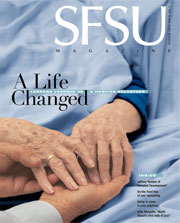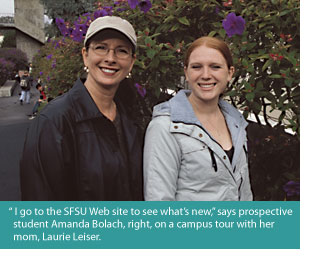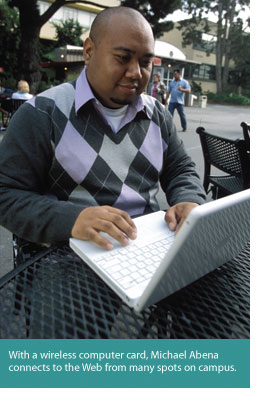 |
| |||
Online, Not In Line
It was the first day of SFSU's fall 2005 priority application period for prospective students. "I was really eager to apply," the Sacramento-area high school senior says a few days later, while waiting with her mom to take a campus tour. "I'm interested in the hospitality management program. I did a lot of research on the Internet and liked what I found at SF State." The CSU moved its admissions process online three years ago. Prospective students who sometimes waited months in the past now usually hear within three or four weeks whether they are admitted. SFSU consolidated all the components of an application -- transcripts, SAT scores and financial aid forms -- into a single Web file that prospective students can access easily to check the status of their application. The convenience and speed of online admissions have spurred an extraordinary growth in the number of electronic applicants. In 2001, just 31 percent of prospective students filed online; by 2004, 92 percent filed electronically. It speeds up the admissions process, is more accurate and cuts down costs. After the tour, Amanda was even more sold on SFSU. "The school's diversity really appeals to me,"she says. "Plus, it's San Francisco!"
Hands down, it's the MySFSU Web site, says Michael Abena, a senior speech communication studies major. Students go to the multi-purpose site to take care of University business that only a few years ago required them to visit administrative offices all over campus, to stand in long lines for financial aid checks and to wait sometimes days or even weeks for information. "The site allows me to do almost everything -- pay bills, get my classes, access my financial records, change my address, and get a copy of my transcript," he says. "I can do all this from my home or wherever I am online." Abena, who works as a campus tour guide and assists at new-student orientation, says knowing how to use the MySFSU site and checking it frequently is key to a new student's success. "It can help keep track of your General Education and other degree requirements," he says. "I tell new students to use it all the time." Abena uses his laptop to do research and homework, send e-mail and surf the Web. Using a wireless card, he can connect to the Internet from most campus locations, including the library and the quad. "With a laptop, I'm not as dependent on the campus computer labs," he says. Getting Classes "People camped out overnight in their sleeping bags," he remembers. "The lines snaked around the quad." Those days -- and the lines -- are now history. Today, students get their classes through Gator Reg. Several weeks before the semester begins, they are given a priority time period to register either online or over the phone using the telephone keypad. After their scheduled time, they can add or drop classes electronically during a generous open registration period. Through SFSU's online class schedule, students view courses by discipline, time, location, size and instructor. As classes fill, they can even see how many seats remain in a particular class and make registration decisions accordingly. Ferguson thinks Gator Reg is SFSU's best tech innovation -- not surprising, since he is the University's assistant registrar. He oversees SFSU's One Stop Student Services Center where students come to take care of a range of school-related business. "There may still be the occasional line," Ferguson says, "but it's nothing like the old days. Thank goodness." Getting A Good Seat Vegher is in Professor Bruce Robertson's "Introduction to Marketing," which uses streaming-video technology to teach registered students. Those who wish to attend Robertson's lecture on Tuesday and Thursday mornings meet at 9:30 in a classroom on campus. The vast majority, however, go online for the class. Each lecture is videotaped, archived and remains accessible 24/7 throughout the semester. A senior in industrial design, Vegher finds the online class convenient. "The experience is virtually the same, except that you can fast forward the parts you understand or pause and replay the parts you don't," she says. Students have to attend the first class and take the final exam on campus. Otherwise, they can take the class entirely online. Since Robertson began teaching the course three years ago, enrollment has more than doubled. In an era of declining state support for higher education, distance-learning classes can be cost-effective. Currently only a handful of SFSU classes are taught entirely online. But hundreds use at least some component of online teaching. Faculty may post their course syllabus, lecture notes and downloadable reading guides online. Students can go online to interact with their professor and other students, take quizzes or check their test grades. "I like that you aren't restricted to a certain time to go to class," Vegher says. "I wouldn't want to take all my classes this way, but this one definitely works for me." Getting the Grade Good news. All but one of his grades appeared on the MySFSU Web site. He liked what he saw. Gone are the days when students had to wait weeks for their grade report to come in the mail. "Sometimes the grades are posted online the same day as the exam," Barredo says. "It's very cool." "Web Grades are a blessing for both faculty and students," says Julien Wade, professor of finance. "As soon as a professor finishes grading the final exam, he or she can determine course grades online and post them from any computer. "Most alumni can recall the post cards they left with their professors the day of the exam, hoping the instructor would remember to send them back with the student's grade," Wade says. "Now an exchange student returning to Germany after final exams can get course grades at the same time as a student living in Daly City, via the Web, and far more quickly." It is Saturday, commencement morning. A nervous Barredo makes one last check to see if the elusive grade has been posted. Not yet. The grade finally appears after commencement. Although it's not quite what Barredo had hoped to see, the new graduate is relieved: "I'm just glad I don't have to worry anymore!" How has technology changed life on campus for you? E-mail your examples:sfsumag@sfsu.edu -- Janet Wade | ||||










 Getting In
Getting In Getting Around
Getting Around